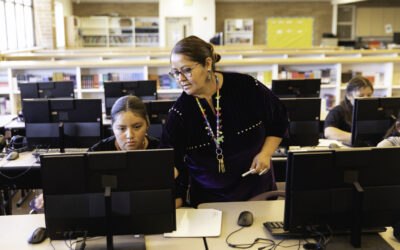On a quest to make education as effective, engaging and scalable as possible, adaptive learning has risen in the tools used by educator to increase the efficacy of education with limited resources. Not only does this technique better harness available resources in a learning environment, but it also helps translate these resources into an overall more successful education for students.
What is Adaptive Learning?
Adaptive learning is the personalization of learning experiences for each individual learner. This includes adapting the curriculum path, changing the speed or difficulty of practice and assessments, the addition of resources to improve certain areas of learning, and more.
Adaptive learning typically harnesses technology to create a more effective learning path based on each individual’s pace of learning. It often takes place on web-based platforms that use algorithms or other technology to measure and personalize the students’ journeys. These personalizations include adapting the content, sequence and assessments for students, as well as improving communication and collaboration among teachers and administrators.
Common Types of Adaptive Learning Customizations
The exact form adaptive learning takes varies from platform to platform. Most will use one or a combination of the following customization methods:
Adapted Content
One of the first ways to customize the learning experience is by adapting content based on the individual learner. This method of adaptive learning provides “hints” or feedback based on a student’s responses to a question, but may not necessarily change the overall sequence of the curriculum.
Personalized Sequencing or Pathways
Another type of adaptive learning includes adaptive sequences or pathways. This uses key indicators of each student’s progress to adapt their individual learning pathway. For instance, if a student is struggling in a content area, the platform may add additional practice and delay introducing a new subject until the previous subject is mastered. If the student is advanced, they may be accelerated through easier topics to get to more challenging content.
Adaptive sequencing can also refer to allowing a student to choose what they would like to learn next instead of setting them on a predefined learning path.
Adapted Assessments
Adaptive learning may also include adapted assessments, which change the type of questions or difficulty of questions in an assessment based on a students’ responses. This acts as an effective benchmarking tool to understand a student’s progress.
Communication & Collaboration
Adaptive learning may also take place by offering the teacher or administrator actionable insight to know when a student may require additional instruction or support, as well as providing resource materials for this assistance. Teachers, students and administrators may also be able to set target goals, progress scales for the class or individual students, or prescribe additional content for individual students, classes or grade levels.
Benefits of Adaptive Learning
There are many benefits of this style of learning to students, teachers, and administrators, including:
- More effective learning. Every student learns differently and at different paces. Adaptive learning helps to nurture each students’ unique needs for a more effective learning environment.
- Improves engagement. Learning paths are specifically designed for each individual student, helping to increase practice opportunities for those who need extra help or accelerate learning for students who advance more quickly. This helps students stay engaged with learning as it matches their individual pace.
- Increased scalability. Adapting curriculum to better fit each students’ unique needs is an ideal in education, but is typically impossible for instructors to manually sustain. Using technology to support a more adaptive learning environment makes the process infinitely more scalable and sustainable.
Learn More
Opportunities for adaptive learning are expected to continue to grow and progress as technology advances the ability for instructors to personalize learning experiences more effectively. There are many benefits to this, including more thorough and effective learning and increased engagement in learning programs. Learning.com’s EasyTech program is one example of an existing learning technology that utilizes adaptive learning for an effective, engaging learning environment for K-12 students. Learn more about this program by clicking the button below.
This article was originally published in March 2022 and was republished in December 2023 for accuracy, completeness, and information.

Learning.com Team
Staff Writers
Founded in 1999, Learning.com provides educators with solutions to prepare their students with critical digital skills. Our web-based curriculum for grades K-12 engages students as they learn keyboarding, online safety, applied productivity tools, computational thinking, coding and more.
Further Reading
How Were the TEKS Created & What is Its Significance?
The Texas Essential Knowledge and Skills (TEKS) framework details the educational standards in the state of Texas, providing a comprehensive outline...
CIPA Compliance Made Easy with Learning.com
The Children’s Internet Protection Act (CIPA), enacted by Congress in 2000, addresses concerns about children’s access to harmful online content. It...
Students as Logical Thinkers: How Computer Science Teaches Real-World Skills
There is little debate that computer science education has become an imperative curriculum for future-ready students. From modern professions and...




